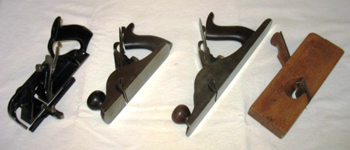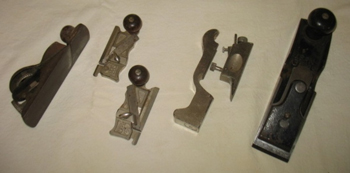The Versatile and Often Necessary Rabbet Plane
by Jeff Pearson


The term rabbet comes from the British word rebate, which is known as a recess or groove cut into the edge of a piece of material, usually wood. The most common rabbet on a boat would be the rabbet that exists on the stem and the keel. There are many ways to cut the rabbet but usually the rabbet would be finished by either a chisel or a rabbet plane. The rabbet needs to be free of irregularities and should be quite fair so that when a plank is fitted to it the caulking can be driven tight and uniform.
To achieve this fairness, a proper rabbet plane should be used. Pictured in the first photo from left to right is the standard #78 Stanley duplex rabbet plane. It has 2 cutter positions and also features a depth stop and fence. Next is the #10 ½ Stanley bench rabbet. This one is the first model and features an adjustable front throat which allows a finer cut with the throat closed up. Next is the Stanley #10 bench rabbet which is longer than the #10 ½. In situations where there is a long open rabbet this is the plane that works best. Stanley also made this plane with tilting handles so you could clear your knuckles in different situations. These planes are rare and fairly pricey. Lastly is a wooden rabbet plane that, while not as user-friendly, certainly has worked for hundreds of years.
In the next photo are some specialty planes that are all rabbets. First from the left is a #140 skewed rabbet block by Stanley. This block has a removable side plate that when removed exposes the cutter out to the edge. These are great little block planes because of the skewed and rabbet feature. Next are a pair of side rabbets, also by Stanley. These narrow rabbets allow you to get into small spaces. Some like them for opening up planking seams. Next is the #93 rabbet plane that features a removable front nose piece that becomes a true bullnose plane and allows the user to cut to the end of their work. This #93 is part of a series of rabbets that come in different sizes and are very useful.
Lastly is a #97 chisel plane by Stanley and it features a cutter that is capable of rabbet work and is a bullnose. There were many other makers of rabbet planes and I will touch on a few. Leonard Bailey first manufactured a rabbet plane from 1877-1888 and it was similar in size to a #4 plane. It featured the opening for the rabbet cut only on one side of the body. It had a depth stop and fence and those parts are usually missing. The other Bailey rabbet plane utilized a vertical post mechanism and was patented in 1855. The Weaver patent looked similar to a #4 plane and was patented in 1875. Boston Metallic also patented a rabbet plane in1873. There were dozens of other makers of rabbet planes back in the days they were trying to come up with the perfect tool.
For more information, contact Jeff Pearson at 207-322-1186.
